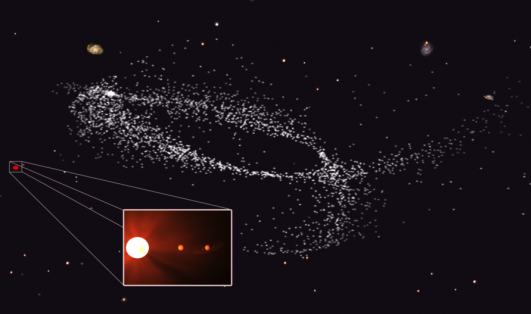An international team of scientists has discovered two new planets orbiting a star nearly as old as the universe, and one of those planets could have the conditions to support life.
Astronomers focused on Kapteyn’s star, the second fastest moving star in the sky and among the brightest and closest, just 13 light-years away.
Discovered at the end of the 19th century and named after the Dutch astronomer who discovered it (Jacobus Kapteyn), Kapteyn’s star is the second-fastest moving star in the sky and belongs to the galactic halo, an extended cloud of stars orbiting our galaxy. With a third of the mass of the Sun, this red dwarf star can be seen in the southern constellation of Pictor with an amateur telescope.
The astronomers used new data from the HARPS spectrometer at the European Southern Observatory’s La Silla Observatory in Chile to measure tiny periodic changes in the motion of the star. Using the Doppler effect, which shifts the star’s light spectrum depending on its velocity, the scientists can work out some properties of these planets, such as their masses and periods of orbit.
The study also combined data from two more high-precision spectrometers to secure the detection: HIRES at Keck Observatory and PFS at Magellan/Las Campanas Observatory.
“We were surprised to find planets orbiting Kapteyn’s star. Previous data showed some moderate excess of variability, so we were looking for very short-period planets when the new signals showed up loud and clear,” explains lead author Guillem Anglada-Escude from QMUL’s School of Physics and Astronomy.
Based on the data collected, the planet Kapetyn b is at least five times as massive as Earth and orbits its host star every 48 days. This means the planet is warm enough for liquid water to be present on its surface. The second planet, Kapteyn c, is a more massive super-Earth and quite different: Its year lasts for 121 days, and astronomers think it’s too cold to support liquid water.
At the moment, only a few properties of the planets are known: approximate masses, orbital periods, and distances to the star. By measuring the atmosphere of these planets with next-generation instruments, scientists will try to find out whether they can bear water.
Typical planetary systems detected by NASA’s Kepler mission are hundreds of light-years away. In contrast, Kapteyn’s star is the 25th nearest star to the sun and is only 13 light-years away from Earth.
What makes this discovery different however, is the peculiar story of the star. Kapteyn’s star was born in a dwarf galaxy absorbed and disrupted by the early Milky Way. This galactic disruption event put the star in its fast halo orbit. The likely remnant core of the original dwarf galaxy is Omega Centauri, an enigmatic globular cluster 16,000 light-years from Earth that contains hundreds of thousands of similarly old suns. This sets the most likely age of the planets at 11.5 billion years, which is 2.5 times older than Earth and “only” 2 billion years younger than the universe itself (around 13.7 billion years).
Anglada-Escude adds: “It does make you wonder what kind of life could have evolved on those planets over such a long time.”
Richard Nelson, head of the Astronomy Unit at QMUL, who didn’t participate in the research, commented: “This discovery is very exciting. It suggests that many potentially habitable worlds will be found in the next years around nearby stars by ground-based and space-based observatories, such as PLATO. Until we have detected a larger number of them, the properties and possible habitability of the near-most planetary systems will remain mysterious.”
Agencies/Canadajournal
 Canada Journal – News of the World Articles and videos to bring you the biggest Canadian news stories from across the country every day
Canada Journal – News of the World Articles and videos to bring you the biggest Canadian news stories from across the country every day



